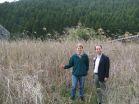(Press-News.org) Tel Aviv -- You know when you're watching a pirated film downloaded from the Internet -- there's no mistaking the fuzzy footage, or the guy in the front row getting up for popcorn. Despite the poor quality, pirated video is a serious problem around the world. Criminal copyright infringement occurs on a massive scale over the Internet, costing the film industry -- and the U.S. economy -- billions of dollars annually.
Now Dr. Alex Bronstein of Tel Aviv University's Department of Electrical Engineering has a new way to stop video pirates. With his twin brother Michael and Israeli researcher Prof. Ron Kimmel, he has developed the ultimate solution: treating video footage like DNA.
Sequencing the video genome
"It's not only members of the animal and plant kingdom that can have DNA," says Dr. Bronstein, who was inspired by DNA sequencing tools used in bioinformatics laboratories. "If a DNA test can identify and catch criminals, we thought that a similar code might be applicable to video. If the code were copied and changed, we'd catch it."
Of course, video does not have a real genetic code like members of the animal kingdom, so Dr. Bronstein and his team created a DNA analogue, like a unique fingerprint, that can be applied to video files. The result is a unique DNA fingerprint for each individual movie anywhere on the planet.
When scenes are altered, colors changed, or film is bootlegged on a camera at the movie theatre, the film can be tracked and traced on the Internet, explains Dr. Bronstein. And, like the films, video thieves can be tracked and caught.
The technology employs an invisible sequence and series of grids applied over the film, turning the footage into a series of numbers. The tool can then scan the content of Web sites where pirated films are believed to be offered, pinpointing subsequent mutations of the original.
The technique is called "video DNA matching." It detects aberrations in pirated video in the same way that biologists detect mutations in the genetic code to determine, for example, an individual's family connections. The technique works by identifying features of the film that remain basically unchanged by typical color and resolution manipulations, and geometric transformations. It's effective even with border changes, commercials added or scenes edited out.
Finding a common onscreen ancestry
The researchers have set their sights on popular video-sharing web sites like YouTube. YouTube, they say, automates the detection of copyright infringement to some degree, but their technique doesn't work when the video has been altered.
The problem with catching bootlegged and pirated video is that it requires thousands of man-hours to watch the content being downloaded. Production companies know their only hope in recouping stolen content is by automating the process. "Video DNA" can provide a more accurate and useful form of this automation.
INFORMATION:
American Friends of Tel Aviv University (www.aftau.org) supports Israel's leading, most comprehensive and most sought-after center of higher learning. Independently ranked 94th among the world's top universities for the impact of its research, TAU's innovations and discoveries are cited more often by the global scientific community than all but 10 other universities.
Internationally recognized for the scope and groundbreaking nature of its research and scholarship, Tel Aviv University consistently produces work with profound implications for the future.
Reading 'Avatar's' DNA
Tel Aviv University researcher turns film sequences into 'genetic code' to catch video pirates
2010-12-22
ELSE PRESS RELEASES FROM THIS DATE:
Preserving a piece of history, whatever the weather
2010-12-22
The Whitworth Meteorological Observatory is a fully-automated, state of the art meteorological facility, replacing the original observatory set up and located in Whitworth Park in August 1892.
The new site, funded by the legacy of Sir Joseph Whitworth, will fulfil his wish to maintain the original observatory as a source of data for scientific, education and popular interest following the demise of the original in 1958.
Data from the new observatory will be used in support of scientific research projects focusing on urban climatology.
They will also be used to support ...
BUSM researchers uncover cellular mechanism responsible for chronic inflammation, Type 2 diabetes
2010-12-22
(Boston) – Researchers from Boston University School of Medicine (BUSM) have demonstrated that certain T cells require input from monocytes in order to maintain their pro-inflammatory response in people with type 2 diabetes (T2D). The study also showed, for the first time, how a loss in homeostasis in this group of T cells most likely promotes chronic inflammation associated with T2D.
Barbara Nikolajczyk, PhD, an associate professor of microbiology and medicine at BUSM, is the senior author of the study, which is currently featured in an online edition of the Journal ...
New Miscanthus hybrid discovery in Japan could open doors for biofuel industry
2010-12-22
In the minds of many, Miscanthus x giganteus is the forerunner in the race of viable feedstock options for lignocellulosic bioenergy production. But researchers believe "putting all their eggs in one basket" could be a big mistake. Scientists at the University of Illinois recently reported the first natural occurrence in several decades of Miscanthus hybrid plants in Japan.
"If M. x giganteus is the only variety available, there are certainly risks involved such as diseases or pests causing widespread establishment problems or yield losses," said Ryan Stewart, assistant ...
Tumor cells in blood may signal worse prognosis in head and neck cancer patients
2010-12-22
COLUMBUS, Ohio – A new study suggests that the presence of tumor cells in the circulating blood of patients with squamous cell cancer of the head and neck may predict disease recurrence and reduced survival. An increased number of circulating tumor cells (CTCs) also correlates with a worse outcome.
Those are the early findings from an ongoing, prospective study of the prognostic importance of CTCs by a team of researchers at The Ohio State University Comprehensive Cancer Center-Arthur G. James Cancer Hospital and Richard J. Solove Research Institute.
The study is ...
Smoking may worsen pain for cancer patients
2010-12-22
Philadelphia, PA, December 21, 2010 – The relationship between smoking and cancer is well established. In a study published in the January 2011 issue of Pain, researchers report evidence to suggest that cancer patients who continue to smoke despite their diagnosis experience greater pain than nonsmokers. They found that for a wide range of cancer types and for cancers in stages I to IV, smoking was associated with increased pain severity and the extent to which pain interfered with a patient's daily routine.
"To elucidate important relations between pain and smoking among ...
Being good moms couldn't save the woolly mammoth
2010-12-22
VIDEO:
Western Ph.D. student Jessica Metcalfe discusses the reasons why woolly mammoths roaming the Yukon Territories thousands of years ago waited so long to eat plants and how she and her...
Click here for more information.
New research from The University of Western Ontario leads investigators to believe that woolly mammoths living north of the Arctic Circle during the Pleistocene Epoch (approx. 150,000 to 40,000 years ago) began weaning infants up to three years later than ...
Parents favor genetic testing for melanoma in their children
2010-12-22
Salt Lake City, Dec.21, 2010—The vast majority of parents who tested positive for a genetic mutation that increases the risk of melanoma (the most serious form of skin cancer) support genetic testing of their children or grandchildren. Results of the two-year study at Huntsman Cancer Institute (HCI) at the University of Utah (U of U) appear in the December issue of the journal Genetics in Medicine. The data could lead to the establishment of formal, evidence-based guidelines for genetic testing of people younger than 18 years.
The study, led by Sancy A. Leachman, M.D., ...
Top research highlighted in fight against heart disease and stroke
2010-12-22
Research on reducing risks, improving medical treatment and improving lifestyle behaviors to fight the battle against heart disease and stroke are among the key scientific findings that make up this year's top cardiovascular and stroke research recognized by the American Heart Association/American Stroke Association.
The association has been compiling an annual list of the top 10 major advances in heart disease and stroke research since 1996. This year, for the first time, two separate lists have been compiled that highlight the top ten research advances in each respective ...
The universe's most massive stars can form in near isolation, new study finds
2010-12-22
ANN ARBOR, Mich.---New observations by University of Michigan astronomers add weight to the theory that the most massive stars in the universe could form essentially anywhere, including in near isolation; they don't need a large stellar cluster nursery.
This is the most detailed observational study to date of massive stars that appear (from the ground) to be alone. The scientists used the Hubble Space Telescope to zoom in on eight of these giants, which range from 20 to 150 times as massive as the Sun. The stars they looked at are in the Small Magellanic Cloud, a dwarf ...
Seminal papers on election law and election administration
2010-12-22
New Rochelle, NY, December 21, 2010—A festschrift honoring Daniel H. Lowenstein, a pioneering legal scholar, Professor at UCLA School of Law, and Founding Co-Editor of Election Law Journal, who devoted his career to advancing election law and campaign finance reform, highlights the current issue of Election Law Journal, a peer-reviewed publication of Mary Ann Liebert, Inc. The issue is available free online.
"Dan quite literally founded the field of election law," says UCLA School of Law professor and colleague of Lowenstein's, Adam Winkler in his introduction. Winkler ...
LAST 30 PRESS RELEASES:
Heart-brain connection: international study reveals the role of the vagus nerve in keeping the heart young
Researchers identify Rb1 as a predictive biomarker for a new therapeutic strategy in some breast cancers
Survey reveals ethical gaps slowing AI adoption in pediatric surgery
Stimulant ADHD medications work differently than thought
AI overestimates how smart people are, according to HSE economists
HSE researchers create genome-wide map of quadruplexes
Scientists boost cell "powerhouses" to burn more calories
Automatic label checking: The missing step in making reliable medical AI
Low daily alcohol intake linked to 50% heightened mouth cancer risk in India
American Meteorological Society announces Rick Spinrad as 2026 President-Elect
Biomass-based carbon capture spotlighted in newly released global climate webinar recording
Illuminating invisible nano pollutants: advanced bioimaging tracks the full journey of emerging nanoscale contaminants in living systems
How does age affect recovery from spinal cord injury?
Novel AI tool offers prognosis for patients with head and neck cancer
Fathers’ microplastic exposure tied to their children’s metabolic problems
Research validates laboratory model for studying high-grade serous ovarian cancer
SIR 2026 delivers transformative breakthroughs in minimally invasive medicine to improve patient care
Stem Cell Reports most downloaded papers of 2025 highlight the breadth and impact of stem cell research
Oxford-led study estimates NHS spends around 3% of its primary and secondary care budget on the health impacts of heat and cold in England
A researcher’s long quest leads to a smart composite breakthrough
Urban wild bees act as “microbial sensors” of city health.
New study finds where you live affects recovery after a hip fracture
Forecasting the impact of fully automated vehicle adoption on US road traffic injuries
Alcohol-related hospitalizations from 2016 to 2022
Semaglutide and hospitalizations in patients with obesity and established cardiovascular disease
Researchers ‘listen in’ to embryo-mother interactions during implantation using a culture system replicating the womb lining
How changing your diet could help save the world
How to make AI truly scalable and reliable for real-time traffic assignment?
Beyond fragmented markets: A new framework for efficient and stable ride-pooling
Can shape priors make road perception more reliable for autonomous driving?
[Press-News.org] Reading 'Avatar's' DNATel Aviv University researcher turns film sequences into 'genetic code' to catch video pirates


